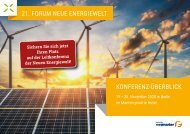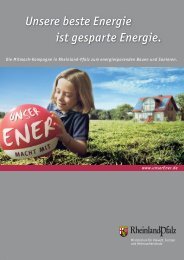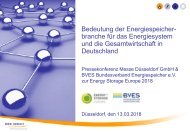Renewable Energy – Solutions for application in the communal energy infrastructure
This brochure contains a selection of successful renewable energy solutions suitable for a range of applications for local and national municipalities and economies. The main energy end-use sectors and the current state of the energy transition are briefly explained to provide readers with an understanding of the transformation of the greater energy system. The renewable energy technology options are explained, including their relevance and applications for municipalities. Finally, a selection of exemplary projects that have been successfully implemented in Europe, the Russian Federation and Central Asia, are included to demonstrate real applications and use-cases for renewable solutions. Renewable energies are cheap, clean and versatile.
This brochure contains a selection of successful renewable energy solutions suitable for a range of applications for local and national municipalities and economies. The main energy end-use sectors and the current state of the energy transition are briefly explained to provide readers with an understanding of the transformation of the greater energy system. The renewable energy technology options are explained, including their relevance and applications for municipalities. Finally, a selection of exemplary projects that have been successfully implemented in Europe, the Russian Federation and Central Asia, are included to demonstrate real applications and use-cases for renewable solutions. Renewable energies are cheap, clean and versatile.
You also want an ePaper? Increase the reach of your titles
YUMPU automatically turns print PDFs into web optimized ePapers that Google loves.
WIND POWER |<br />
19<br />
1<br />
2<br />
3<br />
4<br />
10<br />
5<br />
6<br />
7<br />
8<br />
float<strong>in</strong>g foundations. The control technology <strong>for</strong> <strong>the</strong><br />
system is located at <strong>the</strong> bottom of <strong>the</strong> tower.<br />
W<strong>in</strong>d turb<strong>in</strong>es <strong>for</strong> off-grid <strong>application</strong>s are often not<br />
only smaller but also technically simpler and more robust<br />
than <strong>the</strong>ir larger relatives. They require m<strong>in</strong>imum<br />
ma<strong>in</strong>tenance. Many of <strong>the</strong> small <strong>in</strong>stallations do not<br />
<strong>in</strong>volve free-stand<strong>in</strong>g towers, but ra<strong>the</strong>r masts braced<br />
with steel cables. In addition to <strong>the</strong> classic three-blade<br />
models, <strong>the</strong>re are also various models with a vertical<br />
axis.<br />
11<br />
12<br />
9<br />
13<br />
Construction of a w<strong>in</strong>d turb<strong>in</strong>e:<br />
1) Rotor blade 2) Blade pitch<br />
3) Blade hub 4) Generator brake<br />
5) Gearbox 6) Measur<strong>in</strong>g <strong>in</strong>struments<br />
7) Nacelle 8) Generator<br />
9) Trans<strong>for</strong>mer station 10) Ascent<br />
11) Cable route 12) Tower<br />
13) Foundation<br />
Functional pr<strong>in</strong>ciple and design<br />
Modern w<strong>in</strong>d turb<strong>in</strong>es typically have three rotor blades<br />
made of lightweight and stable fibreglass. The rotor<br />
hub connects <strong>the</strong> blades and transmits <strong>the</strong> movement<br />
to <strong>the</strong> shaft, which leads to <strong>the</strong> <strong>in</strong>side of <strong>the</strong> nacelle situated<br />
at <strong>the</strong> top of <strong>the</strong> tower. The nacelle can be rotated<br />
and can, <strong>the</strong>re<strong>for</strong>e, be aligned accord<strong>in</strong>g to <strong>the</strong> w<strong>in</strong>d’s<br />
direction. The rotor blades can also be adjusted, <strong>in</strong><br />
order that different w<strong>in</strong>d strengths can be utilised to an<br />
optimum, while damage can be avoided dur<strong>in</strong>g storms.<br />
The gears translate <strong>the</strong> slow rotation of <strong>the</strong> rotor shaft<br />
<strong>in</strong>to <strong>the</strong> fast movement of <strong>the</strong> generator.<br />
When plann<strong>in</strong>g a w<strong>in</strong>d farm, <strong>the</strong> first priority is to select<br />
<strong>the</strong> right location. W<strong>in</strong>d speed must be measured at<br />
different heights, while <strong>the</strong> distance and capacity of <strong>the</strong><br />
nearest power l<strong>in</strong>e must be taken <strong>in</strong>to consideration.<br />
Negative effects on human health have not been proven<br />
to date, but a certa<strong>in</strong> distance from settlements and<br />
houses contributes to <strong>the</strong>ir acceptance by <strong>the</strong> broader<br />
population. In order to protect bird and bat species,<br />
w<strong>in</strong>d farms should also be built outside breed<strong>in</strong>g areas,<br />
bird rest<strong>in</strong>g places and nature reserves.<br />
Involv<strong>in</strong>g people from <strong>the</strong> neighbourhood <strong>in</strong> <strong>the</strong> w<strong>in</strong>d<br />
farm and its profits <strong>–</strong> through <strong>the</strong> purchase of shares <strong>–</strong><br />
has also proven successful.<br />
W<strong>in</strong>d turb<strong>in</strong>es are generally designed to have a service<br />
life of about twenty years. Depend<strong>in</strong>g on <strong>the</strong>ir condition,<br />
a general overhaul is <strong>the</strong>n due <strong>in</strong> order to ensure<br />
fur<strong>the</strong>r years of operation. Alternatively, <strong>the</strong> turb<strong>in</strong>es<br />
can be dismantled and replaced by a new, more efficient<br />
turb<strong>in</strong>e. This is known as “repower<strong>in</strong>g”. In view<br />
of <strong>the</strong> fact that <strong>the</strong> turb<strong>in</strong>es are primarily made of concrete<br />
and steel, <strong>the</strong> materials can be fur<strong>the</strong>r recycled <strong>in</strong><br />
<strong>the</strong> usual processes. Recycl<strong>in</strong>g processes are currently<br />
be<strong>in</strong>g developed <strong>for</strong> <strong>the</strong> rotor blades.<br />
In contrast to a photovoltaic system, a w<strong>in</strong>d turb<strong>in</strong>e<br />
supplies alternat<strong>in</strong>g current. The w<strong>in</strong>d turb<strong>in</strong>e tower<br />
can be made of steel or concrete. Lattice towers made<br />
of steel require less material than tubular steel towers.<br />
This makes <strong>the</strong>m lighter and cheaper, but also more<br />
complex to assemble. A foundation of steel and concrete<br />
ensures a solid anchor<strong>in</strong>g. There are various special<br />
construction <strong>for</strong>ms <strong>for</strong> offshore foundations, rang<strong>in</strong>g<br />
from simple piers to gravity-based foundations and








